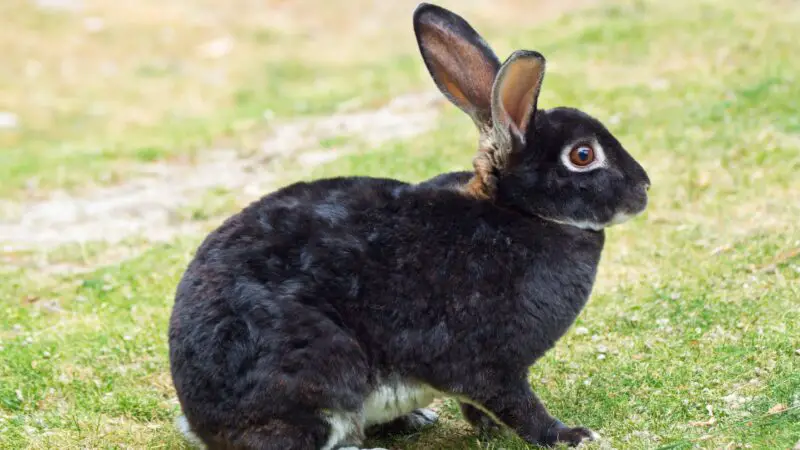Selecting the ideal rabbit breed is a big challenge for first-time rabbit owners since there are nearly 50 recognized breeds by the American Rabbit Breeders Association. However, if you’re interested in show rabbits, the Silver Marten rabbit is the best choice for you!
Silver marten rabbits have a black top color and white under the chin, belly, and tail, as well as inside their ears and nostrils, and around their eyes. Additionally, they have silver markings on their glossy coats. Other than this standard appearance, they also come in 4 varieties: black, blue, chocolate, and sable.
This article discusses everything you need to know about Silver Marten rabbits, their origins, distinctive characteristics, and other relevant information. Read further for more!
Silver Marten Rabbit History

In 1921, the first rabbits were introduced in the United States. Breeders of the Chinchilla rabbit introduced black and tan rabbits into the gene pool as a means of improving the fur pattern and color of the Chinchilla. As a result, a color mutation referred to as “sport” appeared in Chinchilla litters.
At the time, the new rabbits were simply called “strange little black-colored rabbits” until they were officially recognized as a distinct breed, the Silver Marten rabbit, in 1924. It was named so as a reference to the wild marten, which has a mink-like appearance and similar color pattern found on its coat.
By 1927, the Silver Marten Rabbit Club was formed by the breed’s enthusiasts. In the same year, the American Rabbit Breeders Association registered a standard for the Black and Chocolate Silver Marten, while the Blue and Sable varieties were established in 1933 and 1993, respectively.
Today, although these rabbits have endured trials in their populations, they are still considered rare. They are used by rabbit breeders to introduce and influence the color of other Dwarf Rabbit breeds, such as the Netherland Dwarf and the Mini Rex.
What Is a Silver Marten Rabbit?

What Do Silver Marten Rabbits Look Like?
The standard Silver Marten rabbit is characterized by a black top color with white under the neck, chin, belly, and tail, as well as inside the nostrils, ears, and found around their eyes. Some silver tickings adorn their incredibly glossy coat, specifically at the bottom section of their belly.
Other than the standard color, there are 4 other varieties of the Silver Marten rabbit:
- Black. The most popular and common variety is characterized by its jet-black color with contrasting silver markings that have defined shapes, a dark slate blue underside, and dark brown eyes.
- Blue. Dark blue fur with sharp markings that are often late to develop. They have bluish-gray eyes.
- Chocolate. Rich, dark brown overall coloration but with a lighter shade on the tips of the fur on their bellies and brown eyes. Breeders claim that their fur fades over time, especially if they are constantly exposed to sunlight.
- Sable. The rarest variety is characterized by being medium sepia brown in color everywhere except the face, ears, lower legs, tail, and feet soles, which are a darker shade of sepia brown.
How Long Does a Silver Marten Rabbit Live?
Silver Marten rabbits live a life expectancy of 5 to 8 years.
What Do Silver Marten Rabbits Eat?
Silver Marten rabbits are herbivores which means their diets consist mostly of plant material such as grass, fruits, leaves, seeds, and roots. They also tend to occasionally consume their poop during the day to avoid being hungry.
How Big Do Silver Marten Rabbits Grow?
There is currently no information regarding the size of Silver Martens, but since they are medium-sized rabbits, they may range somewhere between 13 to 20 inches in length.
Are Silver Marten Rabbits a Heavy Breed?
Silver Marten rabbits are a relatively heavy breed since they weigh between 6.5 to 8.5 pounds.
What Is Silver Marten Rabbit Known For?
Silver Marten rabbits are primarily raised for exhibition in pet and agricultural shows. They are also kept as pets and used for crossbreeding to improve the coloration of dwarf breeds.
Silver Marten Rabbit Temperament
Silver Marten rabbits are a charming, loveable, and playful breed, hence why they are ideal to keep as pets. However, they are quite shy compared to other domestic rabbits. Fortunately, once they become comfortable with and around you, they will start being more open.
Where Do Silver Marten Rabbits Originate?
They are assumed to originate in the United States, but they are also of French descent since they are bred using the Chinchilla rabbit and other black and tan-colored rabbits.
What Are the Distinct Characteristics of a Silver Marten Rabbit?
Silver Marten rabbits are known for their shiny-looking coat and soft fur.
Are Silver Marten Rabbits Aggressive?
Silver marten is not aggressive, they are a quite gentle and timid breed. However, if they suddenly become aggressive towards humans and other animals, they may have developed an underlying health issue.
How Much Do Silver Marten Rabbits Cost

Although they are hard to find, they only cost around $30 to $60 depending on age and sex. Silver Martens that have descended from bloodlines that are reared for exhibition shows may cost a lot more.
Silver Marten Rabbit Care Tips
Handling
Rabbits are light-boned, which means they can get injured easily when handled improperly. As such, they should be handled after weaning, then handled as often as possible. Never pick them up by their ears, the scruff of their necks, or by the skin on their backs as this can damage their flesh.
When handling, secure hold on their back legs and support them from above. The rabbits are usually comfortable when their back legs are secured and when their rear end is sitting at the elbow of the owner.
Housing
When constructing or converting a building to a rabbitry, it must be enclosed and have proper lighting, ventilation, cooling, and heating systems since rabbits cannot tolerate extreme temperatures. Almost any hutch can be utilized, but metal cages covered with mesh on the top and sides are the best in preventing unsanitary environments.
For the space requirement, Silver Martens will require 4 square feet of cage space. The height should be at a minimum of 16 inches to allow the rabbits to stretch their ears without being able to touch the top of the cage.
Feeders and Waterers
Metal feeders are the most ideal type since they can be kept clean easily, and they could attach and detach to the cage more conveniently. You can also use screen-bottom feeders to reduce the problem of feed fines. For waterers, an automatic nipple-type water system is recommended. They should be placed near the middle of the cage.
Nutrition
For your rabbits, you can either use a commercial pre-balanced pellet ration or a hay and grain mixed diet, as long as they can meet all of the rabbit’s nutritional needs. They also require a fresh supply of clean water available to them every day. 6 to 8 ounces of pellet rations and a gallon of water are required.
Additionally, provide fresh hay at all times. Avoid offering alfalfa hay since it is high in calcium and calories, which can lead to bladder stones in adults. Use timothy, botanical, or orchard grass instead. You can also give 2 cups of dark leafy greens and small pieces of fruit.
Healthcare
Take your Silver Marten rabbit to a veterinarian at least once annually for a routine health examination. Neutering or spaying your bunny can help extend its lifespan. Vaccines are recommended, especially for rabbits that are housed outdoors or those encouraged to play outside.
Breeding Silver Marten Rabbits
- Silver Marten rabbits can begin breeding at 6 to 7 months of age. Males will mature about a month later than females.
- Adhere to a strict breeding schedule since outward signs of heat are not always seen in mature does.
- When breeding, place the female inside the buck’s cage, not the other way around, because the doe may fight the buck to protect their home. One buck can service 10 does, but they should not do so more than 2 to 3 times a week. After allowing them to mate, return the doe to its cage.
- The gestation period lasts about 31 to 32 days. Place a nest box inside the doe’s hutch 28 days after breeding.
- A doe can create a litter of 8 to 10 kits (or baby bunnies). 48 hours after birth, remove any dead animals in the litter. 5 to 21 days after birth, remove the nest box.
Common Health Issues of Silver Marten Rabbits

Although Silver Martens are a hardy and resilient breed, they are not immune to common health issues affecting all rabbits. Here are the following problems you may encounter with your rabbits:
- Parasites. Ticks, fleas, and ear mites are the most common parasites in rabbits. Head shaking, scratching, and dark brown residue found in ears are symptoms of ear mites, while ticks and fleas can be seen easily by the naked eye. All must be treated immediately or infections can occur.
- Bladder Sludge. This is caused by excess protein and calcium in their diets. A telltale symptom is white and cloudy urine. If left untreated, this can cause the development of bladder and kidney stones.
- Malocclusion. This happens when the rabbit’s teeth are misaligned and become overgrown. This causes painful molar spurs and abscesses in the rabbit’s mouth, making it difficult for it to eat.
- Obesity. This is a serious and common problem in pet rabbits caused by protein and carbohydrate-rich diets with little to no exercise. Obesity can cause heart problems and fatty liver disease, which could ultimately kill your rabbits.
- Fractures. Rabbits easily fracture their legs due to their habit of stamping. If they aren’t handled properly, they may break their backs.
